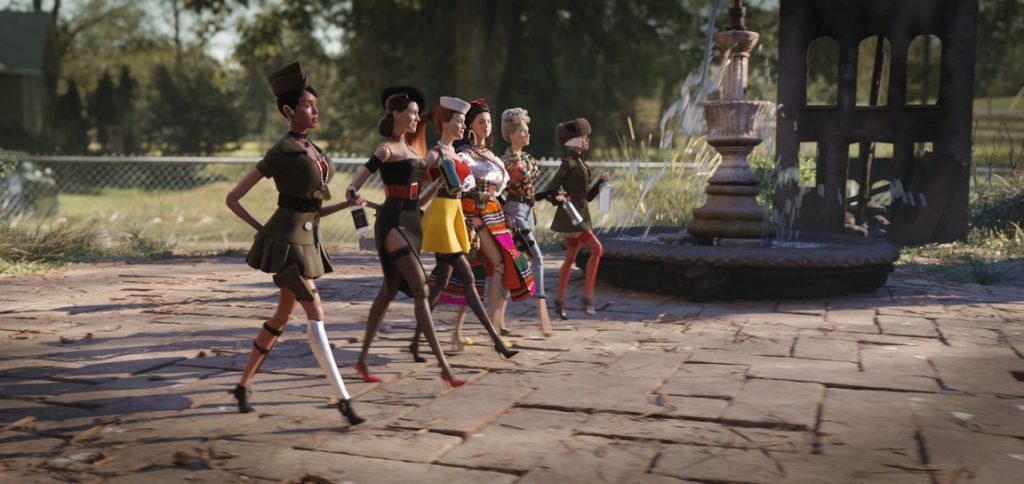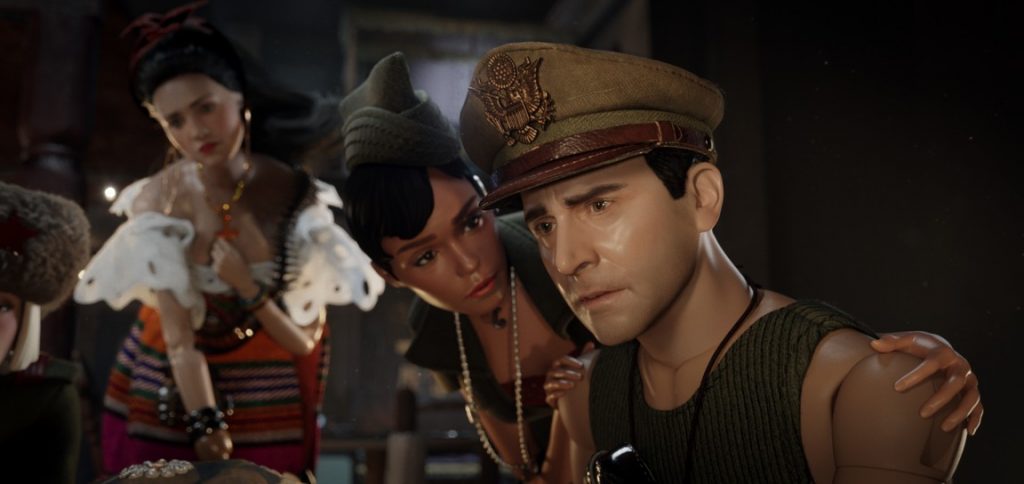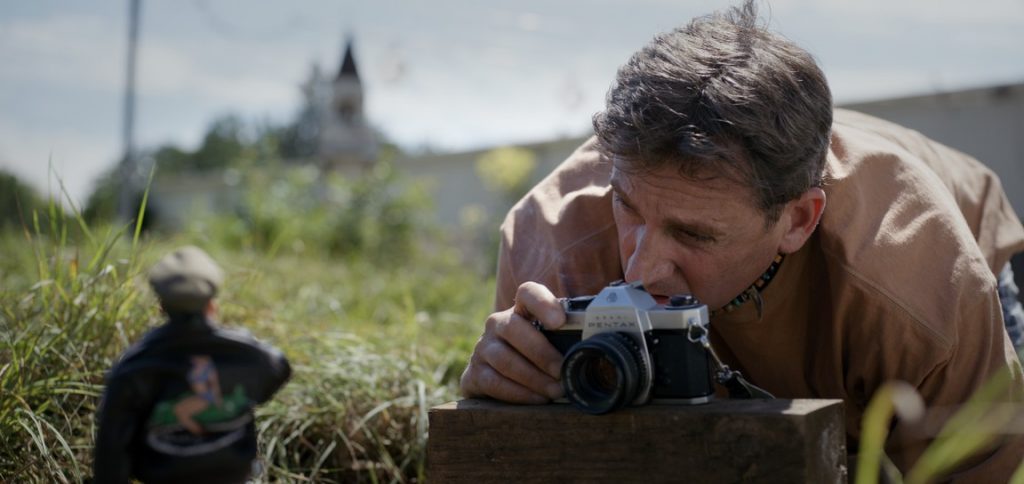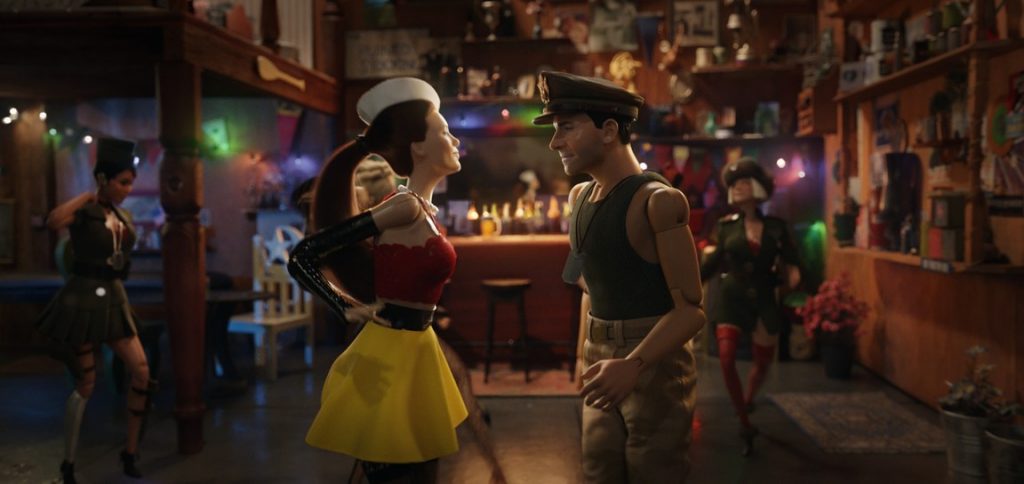Inspired by the 2010 documentary Marwencol, Welcome to Marwen tells the story of artist Mark Hogancamp, played by Steve Carell, who suffered a violent assault that left him with severe brain damage that took away his ability to draw. To cope with the attack, Mark created the fictional town of Marwen and populated it with toy doll versions of himself and the people around him. Shakefire sat down with director Robert Zemeckis and Steve Carell to talk about creating the film’s unique visuals and the power imagination plays in brining Mark’s story to life.
You’ve been in a variety of movies from comedies to drama, but you’ve never been in a big budgeted action movie. Do you, like Mark, ever fantasize about playing an action hero?
Steve Carell: Not really. No, I don’t think I ever have. I’ve never thought of myself in that vein or in that genre. I would do it happily; it would be fun. There’s some movies you think that are in your wheelhouse and others you can’t even imagine. But by the same token, a movie like Foxcatcher, which is completely on the other side of the spectrum, I would have never imagined being in that movie so you never know. Never say never.
Can you talk about the creative choices to blend the doll world with the real world? Was that effortless or was there any particular transition that was more challenging than other transitions?
Robert Zemeckis: Obviously it was something I was thinking about a lot. The plan was to bring the audience in very literally in the beginning of the movie and in the early parts of the movie make it very clear that the audience knew we were transitioning from here to there. As the movie went on and the audience became more comfortable with the language of the film, to then just be cutting between it and not have to worry about it and the audience I think would be immersed in the language of it and they would understand where we would be going.

Did you watch the documentary on Mark and did it help in how you portrayed the part?
Carell: It was the whole impetus for me to be involved with this in the first place. I saw the documentary but I couldn’t get it out of my head. I was moved by him and his story. We did meet him. He’s exactly as you’d hope he’d be, and moreso. He’s a very kind guy and very generous and self-deprecating and really funny too. He has a very dry sense of humor. But short of trying to do him, when you’re portraying somebody who actually exists in the world you don’t want them to feel like they’re a science project; that you’re examining them or trying to see how they drink a cup of coffee. It’s much more about trying to connect with what they went through and what they are as a human being.
The documentary itself is very well received. Did you do anything to make sure you were doing the documentary justice and weren’t just retelling the same information?
Zemeckis: Oh absolutely. I hope that’s what people think. We were very respectful of what the documentary was doing. What I was inspired by when I saw the documentary was, obviously Mark’s story is very moving and very heroic, but I saw that what the documentary couldn’t do that a movie could do was take us into the imagination of Mark. It became very apparent to me when I saw the documentary the first time that he has taken these photos, but in between these photos were these elaborate stories that were only in his mind. I thought that’s what a movie can do that no other medium can do.
Was there any one aspect from the documentary that you made sure you had to get this in our film otherwise what’s the whole point?
Carell: The fact that he likes to wear high heels was integral to the hate crime that he was a victim of. That was an element that was indispensable.
Zemeckis: I would say that every moment that’s in the movie that is representative of the true story I thought was indispensable.
Was the motion captured used in this film more difficult than the animation in say Roger Rabbit or Polar Express, and are there any other technologies that you’d like to explore in the future?
Zemeckis: The performance capture we used in The Polar Express that’s the first time it was ever done in a movie. Did you know that it was invented by the medical profession to study the range of human motion and it was perfected by the golfing industry so they could design better golf clubs? Now we use it in movies. It’s way more advanced than what we did obviously from the way it looks in The Polar Express. Roger Rabbit was old-fashioned literally hand drawn animation, not even the way they do cartoons nowadays with computers. Nowadays an artist on a computer draws a character here and then sixteen frames later draws another and the computer just fills it in, but in the old-fashioned hand drawn days they had to draw every single frame.
Performance capture is wonderful because you have these actors who perform the entire performance of the creature, the avatar, the doll in this case, completely. Animation is kinda like acting in real slow motion. Animators act though their pencil but it takes them weeks to get from there to there where an actor can do it in three seconds. Animators are sorta repressed actors. They want to get out there with their instrument, but they’re happy to do it with their pencil.

How long did it take you to be able to walk in those heels and appear stable?
Carell: I tried to appear not only stable but comfortable and excited about wearing heels. It was months, literally. They sent me heels to my house a couple months before we started shooting and I practiced walking around. I started with wedges and I moved up to three inch, four inch, up to five/six inch stilettos. It was excruciating. I had no idea. At first I thought, “Just get me a pair of women’s shoes in my size and I’ll be good.” And it was not to be. I have a heightened sense of appreciation for how difficult it is. I talked to my wife about it; she gave me tips. I walked around. I videotaped myself. It’s one thing to walk in them, it’s another to look comfortable walking in them. That took some time. My feet were numb for probably a month, a month and a half afterward. I didn’t have any feeling for a while. I don’t for the life of me understand it. My calves look great but…
Mark is such an interesting character. Was it hard to get inside his head?
Carell: It was challenging because you can only assume what this person had gone through and what he’d lost. In talking to the real Mark, he not only lost his memory he lost his ability to speak. He had to relearn how to walk and talk and just how to write his name. His motor skills were severely impaired, and it was a very methodical process back from that. The point at which this film picks up his story, he’s gotten better but he still has a long way to go and a long road ahead of him.
Incidentally last week I got an email from Mark and he said that his motor skills are improving to the point where he’s starting to illustrate again. All of these things that he has done in the real life and the real world have been extremely helpful, not just physically but emotionally. All of that healing that he’s done through this odd little world he created is kinda miraculous. It was definitely a challenge. I just don’t want to be cavalier about explaining how I did it because I can’t even begin to comprehend the sort of pain and suffering this guy went through. In meeting him, I felt like it was my responsibility to at least try to get across the kindness and uncynical nature that is pervasive in him. He’s a remarkable guy.
Steve, you essentially play two characters in this film, Mark and his alter ego Captain Hogie. What was it like juggling these two very different characters in the same film?
Carell: It was fun and exciting to be able to do two characters that were related. There is a thread between them obviously because Captain Hogie is this alter ego, this more perfect version, the imagined version of Mark’s dreams. And I think it’s something a lot of people can identify with because I think everyone secretly has the heroic version of themselves inside. Like what would be more powerful version of me or the more swashbuckling or the stronger or more self confident? He used all those things to kinda live through this other entity to get beyond so much of the pain and fear he was going through. That’s something I think the movie touches on a lot is that Mark lives in perpetual fear and to use a character like that that’s so powerful and to be surrounded by these women who are so powerful to ground yourself in a sense. And also it was just fun to play a swashbuckling stud which I don’t get to do very often.
If you had an imaginary city based around your life, what would it be like? Who would you be like?
Carell: Uh, you mean Carellville? Well, it’s populated by me and my wife and my kids. In Carellville we have a dog. We don’t have a dog in real life, but we have a dog in Carellville, because we can’t have a real dog because my daughter’s allergic. Big dog, probably a big golden retriever or Bernese mountain dog, and it would be the idealized version of that dog. It would be the perfect dog, much like Hogie. It would be populated by things we can’t necessarily have in our real world. My son really wants a dog but we can’t get one. That part of the fantasy would be for him.
Zemeckis: It would be kinda similar to what Steve said but I would be 20 years younger in my ville, Bobville.
With Mark’s artwork, were there certain photos that spoke to you that you recreated for the film or brought into the film?
Zemeckis: Yeah, I’ve got a lot of his actual photos in the movie like his most famous one where the guy is carrying the guy through the mud. Some of them I did take his photos and then recreated them with my dolls because they look like my actors. My favorite one is when the girls are bathing and there’s a Nazi standing over with a rifle and they’re all like, “what!?” Mark took a photo just like that, but then I put my girls in there.
Carell: When Merritt [Wever] comes up in that scene and she says, “Where’s my top?” “Oh, the Nazi’s took it.” “Again.” I love the way she plays that, too. This guy. Those Nazis. I love the way she plays it because it’s also so accepting of him and his world. That’s kinda the spirit of him too. He’s playful. He’s a really sweet funny guy. That part of it can’t be lost. It’s not all doom and gloom. Even though it comes out of a tragedy, he’s got a really good sense of humor.

Can you talk about the supporting cast? You have such a wonderful cast.
Zemeckis: Yeah, we have this magnificent cast. The supporting cast are Mark’s backup, these really empowered females that are his protectors and the people who nurture him. They don’t just him. They accept exactly who he is. I had these great actresses who completely got it. They did such a great job. They just understood what we had to do from beginning to end. I was fortunate because every actress I wanted I got. I sent them the script, and just sparked to it and said they wanted to do this.
One of the things I loved about the film was the attention to detail of both the doll world and real world like with Mark’s journal for instance. How did you compile all of that together?
Zemeckis: Again, everything was inspired by the real Mark. I love the shorthand of being able to show something visually. That’s something movies can do that other art forms can’t. Rather than try to write scenes that try to explain so many complex things, the idea that he was an illustrator allowed me to just run with that. So I did this journal that had these images of self-loathing and things and that just speaks volumes. It’s just there, and how would you even get into that? It just all of a sudden sets the table of this character so instantly that I just love the shorthand of that. Plus the photos of him injured in the hospital, you’re there going “Oh, something happened.” If you don’t know anything about this character, I relish being able to do things like that in a movie, giving these general hints to the audience that something’s going on here.
What kinda challenges did you face when working with CGI and performance capture?
Carell: A lot of it I relied on Bob to explain what was going on around us. There was a crude version of playback of what we could see in our avatars so we could get a glimpse of what this world might look like in a very primitive way, not refined at all. Those things, coupled with out imaginations, is what we used.
Zemeckis: The thing that I chuckle at is the fact that these actors always have this giant imagination. It is in every movie that they do. If you’ve ever been on a movie set, have you ever seen how an actor does his close up? It’s always the most emotional moment in the movie that this actor’s going to perform and now we got to do the close up and it is crazy and bizarre because the director says, “Now look at this piece of tape on this matte box.” Who am I doing this scene with? Oh, you’re doing the scene with her and she’s way back there behind all those other people and you can hear her voice and all these grips with their bellies hanging out and they’re all standing right there and the actors gotta do this moment. It’s crazy! In any movie it’s always crazy so obviously you have to go to an imaginary place to do that.
Carell: It’s true. Even if you’re not in the realm of performance capture, yeah. A lot of times you’re just imagining someone else there.
Zemeckis: It’s making movies. It’s all fake.
Carell: There’s the headline. That’s how you start the article. It’s all fake. It’s just pretend.

I love the imagination of the film. It took me back to my childhood of playing with GI Joes and stuff. What was the one toy from your own childhood that was your go to for imagination play?
Zemeckis: I’m too old for action figures. I missed that one. Now my sister had Barbie dolls, I remember that. I don’t think they did the GI Joe until the mid-60s. I missed that but for people who were younger than me that was a big part of their life. They had those action figures and all that cool gear and all those vehicles that they could put them it.
Carell: I’m sure you haven’t heard of this. It’s an action figure called Major Matt Mason.
Zemeckis: Oh I know Matt. You know who owns the rights to that? Tom Hanks.
Carell: I loved Major Matt Mason. We had a space station, and you could put him on like basically a piece of fishing line and he’s zoom across over to a tree. We had the land rover. Pete Segal, we talked about how much we loved Major Matt Mason and he got me a Major Matt Mason doll at wrap that I have on my shelf.
What do you hope families or individuals who see this, specifically during the holidays, take away from the film?
Zemeckis: It’s hopeful. That’s what I think it is. It’s one of those movies that’s heartbreaking and heartwarming at the same time, and why not? It’s thought provoking, entertaining, sad, and funny. It’s kinda like, for me, everything that I like to see in a movie.
Carell: I think of Mark as someone who lives on the fringe. I feel like this movie itself does in its own way. It’s odd. It doesn’t really fall into a category. It’s not something that’s easily explained. But all those things can be said about Mark. You can’t really classify him. He’s an artist. He’s nonconformist. I think the film itself sorta reflects the person that I see there. I think that the message of acceptance and taking a chance on something you might not get from the external presentation but if you dig a little deeper you can find something kinda beautiful. That’s what I feel about Mark.
Welcome to Marwen opens in theaters nationwide on Friday, December 21.







